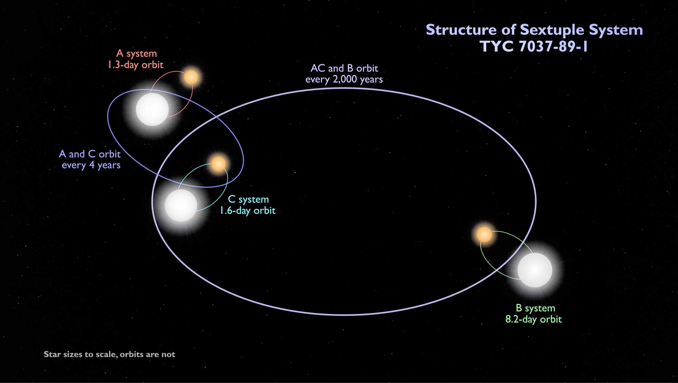
Astronomers studying data from NASA’s Transiting Exoplanet Survey Satellite, or TESS, have found a remarkable sextuple star system featuring three gravitationally bound eclipsing binaries.
The system, known as TYC 7037-89-1, is located about 1,900 light years from Earth in the constellation Eridanus. It is the first known example of six stars making up a trio of eclipsing binaries, known as A, B and C.
The primary stars in all three binaries undergo periodic eclipses, passing in front of each other as viewed by TESS. The changing light curves show all three primary stars are slightly more massive than the sun, but about as hot. The secondary stars are roughly half the size the Sun.
The two stars making up the A binary orbit each other every 1.3 days while the stars in binary C orbit each other every 1.6 days. The A and C binary systems, in turn, orbit each other every four years. The two stars in the B system orbit each other every 8.2 days, but they take about 2,000 years two complete an orbit around the sextuple system’s center of gravity.
TESS was launched to look for exoplanets by measuring the slight change in a star’s brightness when a planet moves in front of its host. It has also “dramatically improved our ability to discovery multiple star systems,” a team led by Brian Powell and astrophysicist Veselin Kostov wrote in a paper accepted by The Astronomical Journal.
A collaboration between Goddard researchers and the MIT Kavli Institute “has found well over 100 triple and quadruple star system candidates,” they write. “The large majority of our discovered candidate triple and quadruple star systems are quadruples.”
“Multiply-eclipsing multiple systems such as TYC 7037-89-1 enable simultaneous, precise measurements on the stellar sizes, temperatures, and potentially masses, of pairs of stars that share common history,” said Kostov, a research scientist at the SETI Institute. “In turn, this provides better understanding of stellar formation and evolution in dynamically-rich environments.”



